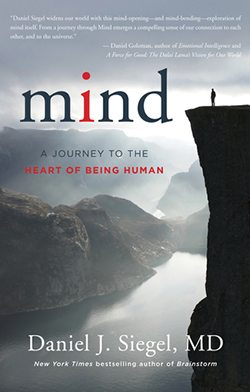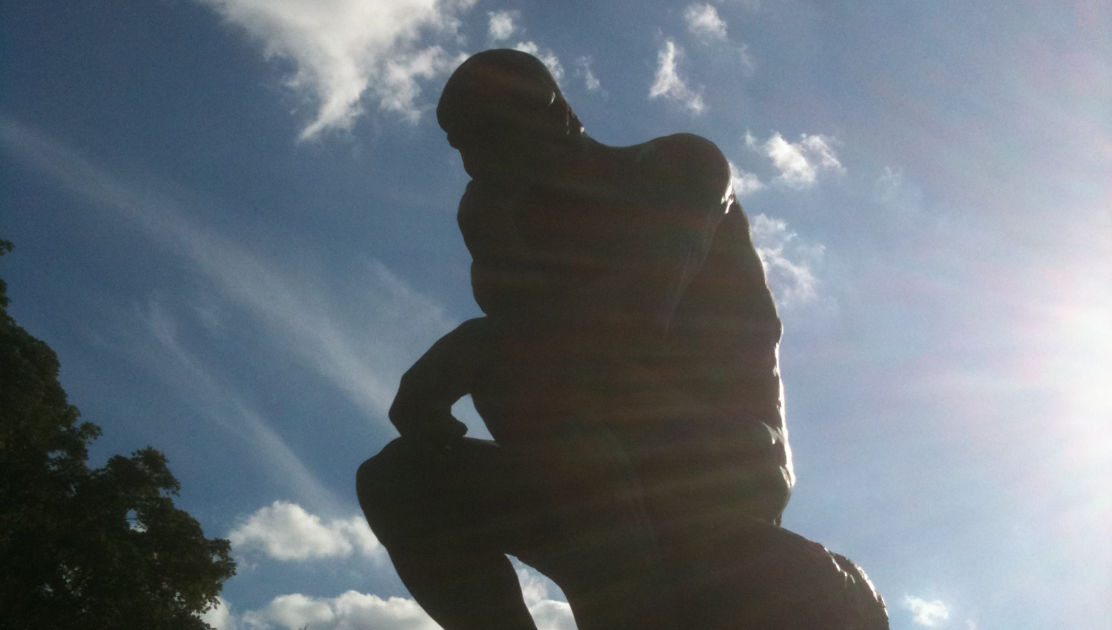The Personal Self is a Construction
Understanding Energy Flow and How We Construct Information
By Daniel SiegelThe following is an excerpt from Dr. Dan Siegel’s book Mind: A Journey to the Heart of Being Human. Along with the New York Society for Ethical Culture and the Blue School, The Garrison Institute co-produced a conversation with Siegel about his new book at the New York Society For Ethical Culture in New York City on November 3, 2016.
[Note: In the excerpt below, top-down refers to ways we have experienced things in the past and created generalized summaries or mental models, also known as schema, of those events. Bottom-up refers to seeing with beginner’s eyes.]
In our journeys through life, unexpected turning points arise, and we often do not understand their long-term impact. As we move from childhood into adolescence, the ways we’ve learned about the world become embedded in the top-down mental models that shape how we continue to perceive and make sense of life as it unfolds. If those models remain unchallenged, we continue in a recursive, self-reinforcing way to create in our interactions the kinds of experiences that simply reinforce what we believe we are. Our top-down constructor can filter experience, create executive decisions on actions, and engage with the world in ways that repeatedly shape what we are immersed in and even how we respond. These repeated experiences are often woven into a tale of our identity as we observe, witness, and narrate a story we’ve told over, and over, and over again about who we are.
At least who we think we are.
Often, few of these top-down constructor processes that shape at least part of the who of who we are come into our awareness.
Our top-down, constructed personal identity may limit our freer, more detailed, sensory-rich, bottom-up living. Something new—even a traumatic injury—can be an invitation to see things with new eyes. But you don’t need to bang your head to shake up your mind. For example, an experience that stirs our sense of who we think we are and opens our minds to new ways of perceiving and experiencing life can be transformed from a helpless trauma to an opportunity for awakening. Sometimes a conversation with another person can initiate more bottom-up; sometimes it is listening to a new poem or song. There are many opportunities to invite the conduit to awaken and constructor to re-evaluate its familiar conclusions about life and identity.
What does awakening the mind really mean? In this case, it means that we have a perspective that we are more than what we think. We are more than what we remember. The notion of a personal self, such as my sense of a “Dan” that lives in this body, is a construction. If repeated knocks on the gravel could knock out my sense of Dan for a day, what was left of the who of me? Clearly, I am more than my identity as Dan. Dan is constructed. What was remaining? Conduition. I could experience the profoundly rich vibrancy of conduit living. Conduition is not constructed. It is as bottom-up as we can come in this life.
That experience was a wake-up call for me to experience a shift in perception, to see that the personal identity self is a personal construction.
 A turning point in one’s life may arise when the top-down filters that shape our feelings, perceptions, thoughts, and actions are suddenly broken down and shaken up, and a new bottom-up experience fills our awareness. In other words, the dominance of top-down from the midline constructor circuits that reciprocally inhibit the lateralized conduit circuits can keep the status quo beliefs about the self, and ways of the self-in-the-world, intact for years, decades, a lifetime. (Wow, those are a lot of words, go constructor!) In short, we can be imprisoned by hidden top-down views of who we think we are. From the cortical column perspective, we can have a top-down set of constraining flows that again and again shape our perceptual experience; we believe that what we keep on seeing is the reality of what is. One way of expressing this is that there is no such thing as immaculate perception. Perception is shaped by top-down learning from prior experience. We need to connect with sensation to begin to liberate us from the potential tyranny of top-down filters often hidden from our awareness. (Go conduit!) Oddly, in writing this paragraph, I can feel some kind of alliance of the two as they engage in what feels like a conduit-constructor duet. Maybe that’s a constructive wish about integration; but it feels like a conduit reality, so maybe it’s just really happening, who knows?
A turning point in one’s life may arise when the top-down filters that shape our feelings, perceptions, thoughts, and actions are suddenly broken down and shaken up, and a new bottom-up experience fills our awareness. In other words, the dominance of top-down from the midline constructor circuits that reciprocally inhibit the lateralized conduit circuits can keep the status quo beliefs about the self, and ways of the self-in-the-world, intact for years, decades, a lifetime. (Wow, those are a lot of words, go constructor!) In short, we can be imprisoned by hidden top-down views of who we think we are. From the cortical column perspective, we can have a top-down set of constraining flows that again and again shape our perceptual experience; we believe that what we keep on seeing is the reality of what is. One way of expressing this is that there is no such thing as immaculate perception. Perception is shaped by top-down learning from prior experience. We need to connect with sensation to begin to liberate us from the potential tyranny of top-down filters often hidden from our awareness. (Go conduit!) Oddly, in writing this paragraph, I can feel some kind of alliance of the two as they engage in what feels like a conduit-constructor duet. Maybe that’s a constructive wish about integration; but it feels like a conduit reality, so maybe it’s just really happening, who knows?
And that’s exactly it. Who are we and who is it that knows?
Can you recall a time when some kind of shift in perspective entered your life? This can be subtle or severe, sudden or gradual, but often this emerging inner sense of clarity may be suffused with a feeling of novelty, as if you haven’t seen this object or had this insight quite in this way before.
If you’ve had such an experience, it may be helpful to reflect on how your mind builds a picture of the world based on what has happened. As we move into our later years, from infancy onward, we live in these bodies whose brains are anticipation machines and pattern detectors, getting ready for next based on what we imagine will happen in the future shaped by what we’ve learned about the past. What this means is that our raw experience of a beginner’s mind, of being in this present sensory now, will be replaced as we age with an expert’s mind. Ironically we’ll be able to see, literally, less clearly, less fully, with less detail, not more. How sad, but how workable if we understand it.
 So who are we? We can say simply we are our minds. But what is this mind exactly? At a minimum we can say that from a bottom-up experience, we are our sensory flow of energy that arises from the outer world and from our inner, bodily world including its brain. This is how we function as a conduit of sensory experience, immersing ourselves in the miracle of being here, in this moment. We are also our top-down experience—ways we filter energy flow into information, symbolic meaning that stands for something beyond the pattern of energy we experience. This is how we are also a constructor of information, not merely a conduit of energy.
So who are we? We can say simply we are our minds. But what is this mind exactly? At a minimum we can say that from a bottom-up experience, we are our sensory flow of energy that arises from the outer world and from our inner, bodily world including its brain. This is how we function as a conduit of sensory experience, immersing ourselves in the miracle of being here, in this moment. We are also our top-down experience—ways we filter energy flow into information, symbolic meaning that stands for something beyond the pattern of energy we experience. This is how we are also a constructor of information, not merely a conduit of energy.
Ironically, having a constructed view of this two-part notion of the who of who we are can help you cultivate the conduit of your life if that is what is needed. How we reflect on our fixed past experiences, live with openness to the emergence of now, and anticipate and shape the flow of open moments in what we call the future, are ways in which our minds continually create who we are in the only thing that exists, the moment of now.
This is a top-down view of who we are. We can OWN it, observing, witnessing, and narrating it. Constructing our experience of life is an important aspect of who we are. In some ways, this can be seen as how the mind creates information from energy flow, beginning with perception from sensation and then moving in ever-more complex ways into memory, conception, and imagination.
Conduition is equally important, only different in its function. Being a conduit is more like being in an experience, enabling the subjective sense of energy flow before it is transformed into the symbolic form we call information. We can strengthen our conduit self by getting in the habit of SIFTing the mind, checking in with direct sensations, images, and feelings, and even sensing the texture of our constructed thoughts. We can temporarily stop reading, stop writing, and be without words, immersing ourselves in drawing, dancing, singing, and simply being.
Befriending both conduition and construction creates a vibrant life of honoring the importance of these fundamental ways of being. Each alone restricts us, each together in our life frees us to live more fully. Construction and conduition are a part of being who we are. Can you feel the energy of such a vision in the conduit of your experience? Can you sense the informational insights in the constructor of your experience? Conduit and constructor, we can welcome both of these facets of who we are right now, in the flow of this moment.
Daniel J. Siegel, MD is a clinical professor of psychiatry at the UCLA School of Medicine, founding co-director of UCLA’s Mindful Awareness Research Center, founding co-investigator at the UCLA Center for Culture, Brain and Development, and executive director of the Mindsight Institute, an educational center devoted to promoting insight, compassion, and empathy in individuals, families, institutions, and communities. Dr. Siegel’s books include Mindsight, The Mindful Brain, Parenting from the Inside Out (with Mary Hartzell, M.Ed.), and the three New York Times bestsellers: Brainstorm, The Whole-Brain Child (with Tina Payne Bryson, Ph.D.), and his latest No-Drama Discipline (with Tina Payne Bryson, Ph.D.). He is a Board Member at the Garrison Institute.
Excerpted from Mind: A Journey to the Heart of Being Human by Daniel J. Siegel, copyright © 2017 by Mind Your Brain, Inc., published with permission of the publisher, W. W. Norton & Company, Inc.
Top image courtesy of Daniel Siegel. Bottom image courtesy of Alex Siegel.
